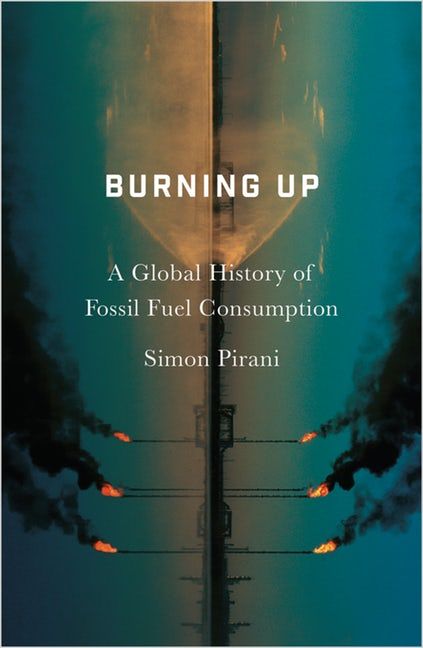Burning Up; A Global History of Fossil Fuel Consumption
Since 1950 we have consumed vastly more fossil fuels than in the whole of human history before that. Piriani's book is a detailed account of the history of fossil fuel consumption and how fossil fuel consumption is embedded into our economic social systems

Published by Pluto Press, 2018
Simon Pirani divides human history into four very unequal periods. Up to the European Industrial Revolution in the eighteenth century most fuel was biomass, primarily wood. From the mid-eighteenth century up to about 1870 coal-fuelled steam engines and coke drove the Industrial Revolution in Western Europe. From about 1870 to 1950 a second Industrial Revolution used oil and gas as well as coal to produce electricity networks, automated manufacturing, internal combustion engine vehicles and petrochemicals. Finally, since 1950 these fossil-fuel-dependant systems have spread outside the rich world and use of oil has surpassed that of coal. These periods are also unequal in the amount of fossil fuels consumed within them, in inverse proportion to their length: in the first two periods it was negligible, but since 1950 we have consumed vastly more fossil fuels than in the whole of human history before that. Pirani’s book reflects this, skipping through the first three periods in an introductory chapter with the remainder of the book devoted to the fourth.
The book is full of lots of detailed facts and figures but the main message can be summed up in what he says in the conclusion:
“People consume fossil fuels through technological systems that are embedded in economic and social systems.” (p.193)
It is misleading to think of our use of fossil fuels in isolation from these systems, or of their consumption in isolation from their production. Growth in fossil fuel consumption has been driven by economic expansion: the expansion of industrialised systems of production (in pursuit of capital accumulation) and the accompanying mass consumption, electrification (in which electricity for industry generally been given priority over the electrification of rural areas), urbanisation and motorisation. Any links with population growth are much more tenuous. Pirani refers to the argument that took place in the 1970s between Paul Ehrlich, an advocate of population control and Barry Commoner, who in his 1971 book The Closing Circle argued that changes to technology, not increases in consumption or growth in population were the key factor in rising resource consumption and environmental impacts. Commoner’s example discussed in an Appendix by Pirani is that the introduction of the non-returnable beer bottle in the USA meant that between 1950 and 1967 the number of bottles used rose by 408%, while population rose by just 30% and consumption per capita by 5% (p. 201). Compared with the impacts of technological systems, people being less greedy, or having fewer children make little difference.
Pirani charts the rise of concern about global warming in the 1980s. A United Nations Environment Programme conference in 1985 concluded that
“a ‘significant’ global warming, caused by the greenhouse effect was likely during the first half of the twenty-first century and scientific-political co-operation was needed” (p. 137).
At a 1988 World Climate Conference in Toronto scientists and diplomats proposed that CO2 emissions should be reduced by 20% of their 1988 levels by 2005. What actually happened was that they were 35.3 % higher. Pirani lays the blame on ' the retreat of Keynesian direction of the economy in the 1980s; the deep prejudice against regulation, underpinned by neo-liberal ideologies .......; and the hostility of coal and oil producers to regulation’ (p.137). In practice the energy policies of the 1990s were shaped by the imperatives of economic growth, not the warm words of the convention agreed at the 1992 Rio Earth Summit.
Pirani is clear that the UN Framework Convention on Climate Change (UNFCCC) process has failed and he does not hold out any hope of its getting to grips with the problem and producing significant cuts in greenhouse gas emissions any time soon. He does see evidence that the transition away from fossil fuels has begun, in the increased investment going into renewable forms of electricity generation. But he argues that fundamental transformation of our technological systems and the social and economic systems that underpin them is required, and that this change needs to be brought about by civil society: market forces and current political processes have demonstrated that they cannot bring about the required transformations (p. 191).
This is not a particularly easy book to read. In places it is rather pedestrian in style and a bit over packed with information. However, it is worth reading as a counter to widely-held views that the roots of our problems lie in people’s values, that we are just too greedy, or that there are too many of us. Changing our individual mindsets will not by itself achieve a move away from fossil fuels; we also need to change the system that we live in.



